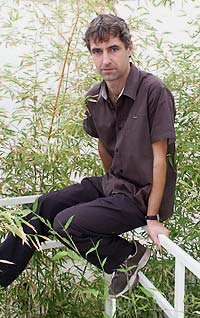Berkeley - Step inside a silicone-sheathed
capsule outside Kroeber Hall at the University of California,
Berkeley, and you'll find yourself amid 58 live bamboo stalks,
tomato seedlings, sauna-like heat and very unusual background
music.
You have just entered "Oxygen Flute 2.0."
This interactive work of art was installed
by Greg Niemeyer, an assistant professor of art, technology
and culture in UC Berkeley's departments of art practice and
film studies, and Chris Chafe, director of the Center for
Computer Research in Music and Acoustics at Stanford University.
 |

Co-creator
Greg Niemeyer inside the Oxygen Flute capsule: "Our
globe is nothing but a much larger container."
|
Niemeyer
and Chafe say their project blends elements of architecture,
music and computers to make statements about the environment,
the interdependence between living things, the global economy,
immigration, modern agriculture and the convergence of the
natural with the synthetic.
But the
artists' central point is to commemorate the tragic deaths
of 58 Chinese immigrants who suffocated in an unventilated
shipping container en route to England in the spring of 2001.
"Our globe
is nothing but a much larger container," says Niemeyer. "The
heat, the carbon cycle and the fragile air quality of the
(Oxygen Flute 2.0) chamber reference the greenhouse effect,
which makes the Earth's atmosphere as hospitable as the freight
container in which the Chinese immigrants died."
Although
bamboo is a fast-growing plant with a particularly rapid metabolism
of carbon dioxide, Niemeyer and Chafe say that if the chamber
were entirely sealed, one human could deplete the chamber's
oxygen supply within 12 hours.
The humid
white capsule, which resembles a small greenhouse, can hold
approximately two visitors at a time. Inside, people stand
on a metal walkway - with green bamboo stalks surrounding
them and tomato plants below - to experience changes in carbon
monoxide levels triggered by their own breathing. As the levels
fluctuate, computer-simulated flute music inside the structure
also changes.
Chafe and
Niemeyer say they hope people walk away from the capsule with
increased consciousness about air and air quality, about breathing
and living and survival.
Their original
"Oxygen Flute" was commissioned in 2000 for the San Jose Museum
of Art and was displayed there last year.
Since then,
Niemeyer and Chafe have deepened some of the flute sounds
and planted the tomatoes inside. The new plants symbolize
the crates of tomatoes the Chinese immigrants were hiding
behind in the container. The fruit had been picked to ripen
during shipping, burning oxygen and releasing "an enormous
amount" of carbon dioxide inside the container, Niemeyer says.
"It's like
an ongoing experiment," he says of the capsule, "with the
viewers being the human subjects involved. The piece only
exists as a performance; it only exists if you go inside."
The installation
is equipped with computers, speakers, fluorescent lights,
a computer and a carbon dioxide gas sensing system. A sensor
dispatches information to an Intel Linux computer about the
carbon dioxide in the air, measured in parts per million.
The average measurement in Berkeley is about 300 parts per
million, Niemeyer says, and people entering the small chamber
can temporarily elevate the carbon dioxide level to over 20,000
parts per million.
Visitors'
breathing patterns change the carbon dioxide levels. Data
about those levels trigger a computerized music program, driving
one pair of flute sound synthesis models in two different
ways to stretch the length of the flute note and vary the
pitch of the sound. This creates an ever-changing and complex
musical environment inside the capsule.
The sounds
are based on a physical modeling and simulation of 9,000-year-old
bone flutes excavated from the Jiahu site in China's Henan
province. The computerized simulations of the flutes with
their unusually-placed tone holes produce what Niemeyer calls
"slightly dissonant, very old sounds."
A percussive,
popcorn-like sound continuously filling the background is
actually the sound of thousands of shrimp, about one centimeter
in size, snapping with their large claws. It was recorded
by a hydrophone at Hopkins Marine Station in Monterey Bay.
The installation
- funded by an Intel Corporation art and technology grant
- relied on 3-D modeling software, sound system programming
and simulation of the entire system with computer graphic
animation movies before construction. Its walls of stretched
sheets of silicone rubber shimmer and stir the air inside,
causing the bamboo to slightly tremble.
An official
opening ceremony for Oxygen Flute 2.0 is set for 7:30 p.m.
Monday, Nov. 4.
It will
feature a special concert presentation of "Ping," a collaboration
by Niemeyer and Chafe that makes audible the time lag that
takes place when moving information between networked computers.
There also will be a jazz saxophone/Oxygen Flute 2.0 duet
featuring Bay Area musician Anton Schwartz, and a talk about
the project by Dana Plautz, director of research communications
at Intel Corp.
Oxygen
Flute 2.0 is hosted by UC Berkeley's Phoebe Apperson Hearst
Museum of Anthropology and curated by Constance Lewallen of
the Berkeley Art Museum.